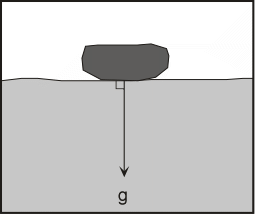
| EENS 1110 | Physical Geology |
| Tulane University |
Prof. Stephen A. Nelson
|
Mass Movements |
|
|
|
| Mass movements (also called mass-wasting) is the down-slope movement of Regolith (loose
uncemented mixture of soil and rock particles that covers the Earth's surface) by the
force of gravity without the aid of a transporting medium such as water, ice, or wind.
Still, as we shall see, water plays a key role.
Mass movements are part of a continuum of
erosional processes between weathering and stream transport. Mass movement causes regolith and rock
to move down-slope where sooner or later the loose particles will be picked up by another
transporting agent and eventually moved to a site of deposition such as an ocean basin or
lake bed. Mass movement processes are occurring continuously on all slopes; some act very slowly, others occur very suddenly, often with disastrous results. In this discussion, we hope to answer the following questions:
We start with a discussion of the forces acting at the surface that cause mass movements. Gravity Gravity is the main force responsible for mass movements. |
| Gravity is a force that acts everywhere on the Earth's surface, pulling everything in a direction toward the center of the Earth. On a flat surface, parallel to the Earth's surface, the force of gravity acts downward. So long as the material remains on the flat surface it will not move under the force of gravity. Of course if the material forming the flat surface becomes weak or fails, then the unsupported support mass will move downward. |  |
| On a slope, the force of gravity can be resolved into two components: a
component acting perpendicular to the slope, and a component acting parallel to the
slope. |
|
|
|
|
The Role of Water Although water is not always directly involved as the transporting medium in mass movement processes, it does play an important role. Addition of water from rainfall or snow melt adds weight to the slope. Water can seep into the soil or rock and replace the air in the pore space or fractures. Since water is heavier than air, this increases the weight of the soil. If the material becomes saturated with water, vibrations could cause liquifaction to occur, just like often happens during earthquakes. Water can reduce the friction along a sliding surface. Water has the ability to change the angle of repose (the slope angle which is the stable angle for the slope). Think about building a sand castle on the beach. If the sand is totally dry, it is impossible to build a pile of sand with a steep face like a castle wall. If the sand is somewhat wet, however, one can build a vertical wall. If the sand is too wet, then it flows like a fluid and cannot remain in position as a wall. |
|
|
|
|
|
|
|
|
|
Troublesome Earth Materials
|
|
Another material that shows similar swelling and compaction as a result of addition or removal of water is peat. Peat is organic-rich material accumulated in the bottoms of swamps as decaying vegetable matter. |
|
|
Compaction of the soil or shaking of the soil can thus cause a rapid change in the structure of the material. The clay minerals will then line up with one another and the open space will be reduced. But this may cause a loss in shear strength of the soil and result in slippage down slope or liquefaction. |
Weak Materials and Structures Rocks often contain planar structures that become slippage surfaces if weight is added or support is removed.
|
Mass Movement Processes
The down-slope movement of material, whether it be bedrock, regolith, or a mixture
of these, is commonly referred to as a landslide. All of these processes
generally grade into one another, so classification of mass movement processes is somewhat
difficult. We will use a common classification of mass movements, which divides the processes into two broad categories and further subdivides these categories.
|
Slope Failures
|
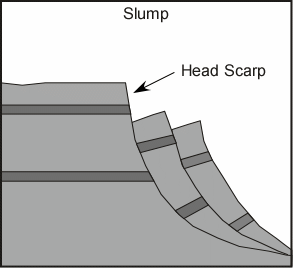 |
|
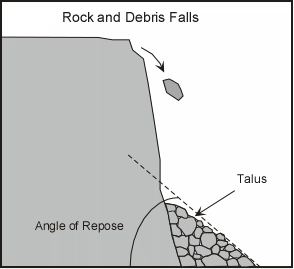 |
|
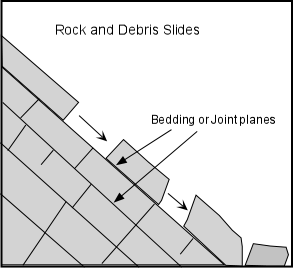 |
|
Sediment Flows Sediment flows occur when sufficient force is applied to rocks and regolith that they begin to flow down slope. A sediment flow is a mixture of rock, regolith with some water. They can be broken into two types depending on the amount of water present.
Each of these classes of sediment flows can be further subdivided on the basis of the velocity at which flowage occurs. |
|
|
|
|
|
Mass-Movements in Cold Climates Mass movements in cold climates is governed by the fact that water is frozen as ice during long periods of the year. Ice, although it is solid, does have the ability to flow, and freezing and thawing cycles can also contribute to movement.
Subaqueous Mass movement Mass movements also occur on slopes in
the ocean basins. Most slope failure can occur due to
over-accumulation of sediment on slope or in a submarine canyon,
or could occur as a result of a shock like an earthquake. 3 types can occur - (1) Submarine slumps – Coherent blocks break and slip, similar to slumps on land. (2)
Submarine debris flows – Moving material breaks apart and flows, similar to debris flows on land. (3) Sediment moves as a turbulent cloud, called a turbidity current. (See figure 16.10 in your text). Gigantic submarine slope failures are widespread on the ocean floor, particularly around islands like Hawaii and off the east and gulf coasts of North America. They are much larger than land-based slope failures and are an important process sculpting adjacent land. When they occur, they create catastrophic tsunamis. (See figures 16.11 in your text). |
| Triggering Events
A mass movement can occur any time a slope becomes unstable. Sometimes, as in the case of creep or solifluction, the slope is unstable all of the time and the process is continuous. But other times, triggering events can occur that cause a sudden instability to occur. Here we discuss major triggering events, but it should be noted that it if a slope is very close to instability, only a minor event may be necessary to cause a failure and disaster. This may be something as simple as an ant removing the single grain of sand that holds the slope in place.
|
|
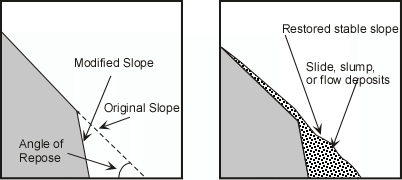 |
|
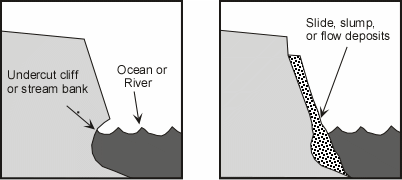 |
|
|
Assessing Mass Movement Hazards As we have seen mass movements can be extremely hazardous and result in extensive loss of life and property. But, in most cases, areas that are prone to such hazards can be recognized with some geologic knowledge, slopes can be stabilized or avoided, and warning systems can be put in place that can reduce vulnerability. Because there is usually evidence in the form of distinctive deposits and geologic structures left by recent mass movements, it is possible to construct maps of all areas prone to possible landslide hazards (see the National Landslide hazards map at http://landslides.usgs.gov/hazards/nationalmap/). Detailed local maps can usually be obtained from individual state agencies. Planners can use such hazards maps to make decisions about land use policies in such areas or, as will be discussed below, steps can be taken to stabilize slopes to attempt to prevent a disaster or minimize its effects. Short-term prediction of mass-wasting events is somewhat more problematical. For earthquake triggered events, the same problems that are inherent in earthquake prediction are present. Slope destabilization and undercutting triggered events require constant monitoring. Mass movement hazards from volcanic eruptions can be predicted with the same degree of certainty that volcanic eruptions can be predicted, but again, the threat has to be realized and warnings need to be heeded. Hydrologic conditions such as heavy precipitation can be forecast with some certainty, and warnings can be issued to areas that might be susceptible to mass movement processes caused by such conditions. Still, it is difficult of know exactly which hill slope of the millions that exist will be vulnerable to an event triggered by heavy rainfall. Some warning signs can be recognized by observations of things around you:
Prevention and Mitigation
Some slopes, however, cannot be stabilized, or only stabilized at great expense. In these cases, humans should avoid these areas or use them for purposes that will not increase susceptibility of lives or property to mass movement hazards. Conclusion Hopefully the information provided here will help you avoid death or loss of your property by mass movement |
Examples of questions on this material that could be asked on an exam
|